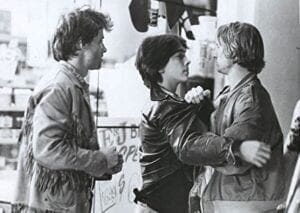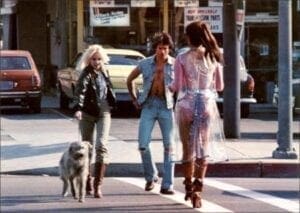Foxes
"Sweet sixteen and never been kids."
(1980)
starring Jodie Foster, Cherie Currie and Scott Baio

PODCAST:
'80s Movies: A Guide to What's Wrong with Your Parents -
How Foxes is a Time Machine to Teen Life in 1980.

Four 16-year-old friends living in LA's San Fernando Valley find that high school is no preparation for the real world.
Why it’s rad:
- The Runaways lead singer Cherie Currie in her film debut.
- Jodie Foster's last film as a kid.
- It's Chachi!
- Reteaming of Bugsy Malone (1977) stars Jodie Foster and Scott Baio
- Amazing soundtrack with Cher, Donna Summer and Boston.
- Highlights the hairstyles, wardrobe, and pop culture of 1979.
So '80s...Or Rather, 1979:

While Foxes was released in 1980, it was made in 1979 and incorporates all the pop culture of the late '70s.
- Jeannie's room identifies the key items of teen room decor: posters of John Travolta and the band KISS, Twinkies, Clearasil.
- The drugs were popular in the late '70s: quaaludes, angel dust, PCP, and of course, marijuana.
- The hair: Annie's feathered bangs with stick straight hair, Dierdre's crimped updo at the concert, and the boys long shaggy cuts.
- The fashion: Dierdre's shiny disco leotard and lycra pants, Jeannie's Annie Hall menswear, Madge's Stepford Wives ruffled dress and wide brimmed sunhat, Annie's tube top-type blouses, and the tuxes on the dinner guests.
- The bird marionette being "walked" on Hollywood Boulevard was a toy that was everywhere.
- "I ate the whole thing" T-shirt was taken from the Tums commercial where a guy with a tummy ache moans over and over: "I can't believe I ate the whole thing!"
- Skateboarding: Four wheels and a board became popular in the mid-'70s and grew in popularity.
Historical Perspective
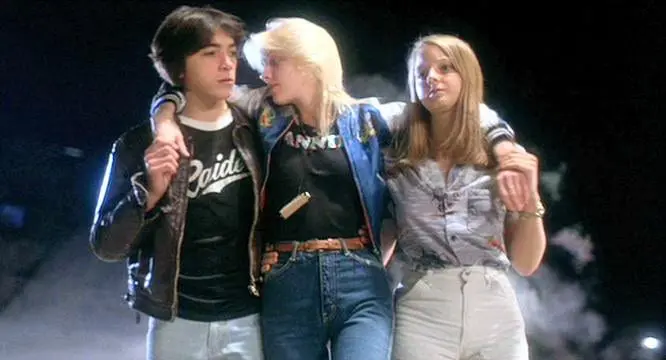
Self-absorbed parenting. Adults living in the 1970s and early '80s were dubbed the "Me Generation." Several movements of the late '60s and '70s were about introspection, self-help, and "finding yourself." Additionally, women's lib led to many wives deciding liberation included freedom from marital bonds and divorce was on the rise. Jeannie's mom Mary and Dierdre's mother show that old habits die hard: Mary is sleeping with married men and Dierdre's mother already remarried, but still dislikes competing with her daughter for attention.
Permissive Era and the Decadence of the 1970s. In the throes of the Sexual Revolution, everything in the 1970s was about sex: the skintight clothes, dancing in discos, drinking, smoking, swearing - it was all about living large, having fun, and having lots of sex. All of the taboos of previous generations were thrown out the window, including interracial, same gender relationships, and it appears, the age of consent. Society tended to turn a blind eye to men dating/marrying/having sex with a minor. Statutory rape and rape was rampant.
"[Her dad] put handcuffs on her because she got pregnant by some guy and he acts like she's some sort of fallen woman or something. All she wanted to do was go out and get an abortion, no s--t, Mr. Simmonds!". Roe v. Wade consumed the political landscape in the early '70s and became legal in 1973. Two-thirds of Americans supported the idea that the choice of abortion should be a decision made between a woman and her doctor. By the late '70s, a small but dedicated group of Catholic activists set out to change minds. While support for Roe v. Wade is actually higher than it was in the 1970s, decades of protests have created a shame and guilt associated with terminating pregnancy, making it seem shocking when Jeannie tells the Principal that Annie's dad freaked out when Annie's sister just wanted to get an abortion -- but not as shocking to see that Annie's father handcuffed her to prevent her from doing so.
Domestic abuse. Annie's father is abusive, seen when he tracks his daughter down and physically attacks her and implied with the way Annie's mother behaves ("I don't tell the man nothing") and Annie's comment in the next scene -- "I can't feel sorry for my mom, not when she takes s--t from my dad." It's also clear Mr. Simmonds does know this, but the fact that he's still trying to get Annie to go home speaks to the acceptance of domestic abuse at the time -- and how police wouldn't get involved with how a man chose to discipline his kids or his wife.
Teen runaways. The rate of teenagers running away from home was on the rise in the 1970s and 80s, likely due to all the reasons above. With adults tuning out to tune inward, drug use and addiction and alcoholism were also on the rise, which leads to poor parenting. Abuse, addiction, sexual molestation were some of the reasons kids were fleeing their homes. Additionally, there were "thrownaway" kids whose parents "threw them out" of the house. And, then there were the "flower children" Annie refers to, kids lured by religious cults or those who wanted to embrace the hippie lifestyle looking for a commune. Entertainment and news organizations stepped up to try and warn about the potential consequences facing runaways: drugs, rape, crime, and prostitution -- as apparently had occurred with Annie. The problem clearly didn't lie with the kids: an article that ran in the New York Times quotes an alarmed suburban social worker: "There are more and more parents who are not even calling to find out where their kids are,'' Dr. Moran said. The parents, she said, ''are barely surviving themselves.''
"All those desperately lonely, divorced UCLA undergraduates." Divorce spiked in the 1970s with 1979 recording the highest rate with 5.2 of 1000 marriages ending in divorce. Life before this had few women in the workforce and alimony from ex-husbands was a given. However, the rising divorce rate was connected to the feminist movement and women's desire to pursue careers. The result, as Sally Kellerman's character Mary so bitterly states, is that adult female divorcees were filling college campuses to obtain degrees that would allow them to achieve their dreams.
Substances were legal. The minimum drinking age wasn't pushed to 21 until 1984, so 18-year-olds could legally buy and drink alcohol in 1979 and 1980, although drinking between classes was likely against the school's code of conduct. Quaaludes were legal and sometimes "prescribed" to treat anxiety by "stress clinics" until 1984. PCP/"angel dust" became illegal in 1978. And marijuana, well that was illegal since 1937 but definitely saw a resurgence in the 1960s and '70s (although it eroded in popularity during the '80s).
Skateboarding. Skateboarding became immensely popular in the 1970s, the trend starting in 1972 when urethane wheels were invented that made it a lot easier to control the board. In 1978, the "Ollie" skateboarding trick was invented (we think we remember Brad showing off the move in the film), which took the sport/mode of transportation to a whole new level. A skateboarding hero just makes sense in a teen film.
What’s your damage?
Foxes does not glamorize the boozy, sexed-up, pot smoking teen world. However, as AV Club points out about Foxes: “To paraphrase François Truffaut, there’s no such thing as an anti-teen decadence film, because there’s no way to portray teen decadence without glamorizing it.”
Still, it was marketed as Girls Gone Wild! salacious teen indulgence film. The trailer and the movie poster positioned the film as a teensploitation film, although it was the opposite. The trailer voice over states they're "not exactly the girls next door" and position the girls as faster than the norm: showing Annie running from a cop (without acknowledgment that it's her dad), Brad asking Annie if he can stay with her (and not including her telling him no), shirtless Randy Quaid (not acknowledging its Madge losing her virginity), and showing the party as a fun time - not one in which the girls are stressed out about. The original tag line was: "Daring to Do It!"
Foxes is more of an indicator than an influencer of teen life in 1980. Foxes was not a hit and wasn't really seen enough to consider it an influence. Moreover, it paints a picture of teens who aren't living fast as much as they're living hard. Why does Jeannie want to get a place for her friends? As a get away from their parents, from trouble, and from distracting and upsetting boys. Jeannie, as the voice of sanity in the film, speaks about "the heavy stoned" days, going to yogi communes, and has to check in with a pimp to locate her friend. Jeannie knows her friend Madge will marry the first guy she sleeps with, and does. Jeannie knows Dierdre is so caught up in trying to be seen as as a sexual object that she'll always choose guys over girlfriends. And, Jeannie knows Annie is unlikely to survive high school due to drugs and alcohol abuse. Jeannie makes it clear that teens shouldn't be enamored with rock n roll lifestyle, but rather, should just want a place to live in peace, quiet, and friendship.
Behind the Scenes
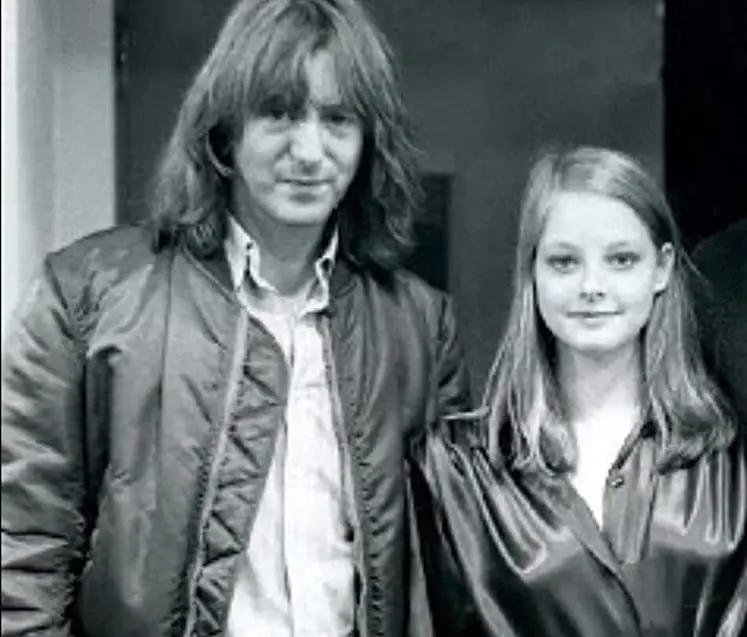
HOW IT CAME TO BE
A former Columbia Studios executive was thinking about Louisa May Alcott. Gerald Ayres was a had been the Vice President of Creative Affairs at Columbia and left the studio with a three-picture deal. After completing Cisco Peak and The Last Detail, he had a notion: "What would happen if you dropped Louisa May Alcott into the San Fernando Valley today?”
A creative exec at 20th Century Fox greenlit the film over lunch. Ayers casually told David Begelman about a conversation he'd had with his 14-year-old daughter, Liz. He was shocked at how wild teens were. According to his autobiography "Everywhere Hollywood," Ayers conversation with Begelman went like this:
Ayers: One is having an abortion. One is being kept by a wealthy man and it's cool because they really are in love and she seldom goes home which is okay with mama because the girl has money and starts paying her rent.
Begelman: How old is the girl?
Ayers: What does it matter? It's true love.
Begelman: Yeah, go on.
Ayers: Then there's all sorts of drugs bought at the school. It's a real problem for one friend who crashed her father's car which he let her drive even though she didn't have a license. You know, Daddy was guilty for never being around cause he's shacked up with his own hot little ticket.
Begelman: I get the idea.
Ayers: Every chance they get, these girls race off to Hollywood Boulevard to get a true taste of what life is about. This all came from my daughter's mouth. She claimed she only went down to the boulevard to rescue her closest friend who was being stashed away somewhere by a pimp in a rabbit fur hat. I wonder what would Louisa May Alcott write about if she were dropped in the San Fernando Valley today?"
Begelman: Why don't you write about it?
Ayers: About these girls?
Begelman: Little Women in the Valley. I could get Fox to sign on to that.
Foxes is "Little Women" in the 1970s. So, Ayres started drafting a script based on his 14-year-old daughter Liz and three of her friends, melding them in the framework of the characters from "Little Women," although switching up characteristics and story beats. The Alcott names were kept in place through many drafts, but eventually "Jo" became "Jeannie," "Meg" became "Madge," "Beth" became "Dierdre," and "Amy" became "Annie."
Ayres did research by hanging out with his teen daughter and her friends. He spent five months observing and interviewing students at North Hollywood High. He writes that he was allowed to sit in on classes and the girls at the school befriended him: "They had my phone number and one in particular called me nightly to complain about her parents and dish her classmates. I would listen sympathetically and write notes as fast as I could."
Twentieth-Century Fox developed the script and called it Twentieth Century Foxes. Eventually, 20th Century Fox wanted to abandon the "Little Women" adaptation, feeling connecting to a 100-year-old literary classic would be off-putting to modern teens. The first draft was complete at the end of 1977.
Bugsy Malone executive producer David Puttnam took to the script. Ayers' longtime collaborator and one-time lover (the one who introduced him to homosexuality, according to his autobiography) Jacques Demy handed the script to British producer David Puttnam when they were seated next to each other on a long flight. Puttnam sparked to the concept because, according to AFI Catalog, it reminded him of the "privileged children who grew up in Beverly Hills."
Fox is out, but Puttnam convinces Casablanca Records to take over. In 1977, former Columbia Studios exec Peter Guber started Filmworks, a motion picture subsidiary of Casablanca Records. The concept was to make movies to feature Casablanca recording artists and fuel popularity and sales. This is pre-MTV but promotional videos were beginning to make a positive impact in creating hits, particularly Queen's "Bohemian Rhapsody" in 1975, in addition to a history of successful music movies from the Beatles and TV shows like "The Monkees" and "The Partridge Family." Casablanca Records + Filmworks experienced initial success with The Deep (1977) and Midnight Express (1978). They also suffered a flop with Thank God It's Friday (1978), but the film won an Academy Award, a Golden Globe, a Grammy, and a couple of American Music Awards for Donna Summer's Last Dance -- so, the film was a success in the eyes of the studio.
Title changes. Well, obviously the title Twentieth Century Foxes was out once the film was not going to be produced at the studio who carries that name, so Ayres has to abandon his title. Ladies of the Valley becomes the new title until it's agreed to just settle on the simple: Foxes, a term of the era that meant "hot."
Commercial director Adrian Lyne is hired to direct. One problem. Ayers was already promised he could direct his script. David Puttnam brought in a fellow Brit and fellow ad man (Puttnam also started in advertising) to give him his first shot at a feature film. Lyne was in Palmdale, Calif, shooting a Levi's commercial when Puttnam, a professional acquaintance, met with him about the film. In the book "Film Directors on Directing," Lyne told author John A. Gallagher, "He gave me the script and said that he was sure [United Artists] would want an American director 'cause it's an American subject. I liked it quite a lot. I thought it was an honest, documentary-style look at these kids in the San Fernando Valley trying to grow up and be independent."
Ayers learned he'd been replaced from an actor who'd just been at an audition for his film. Ayers wrote that an actor he knew -- "one of the flock who partied around gay West Hollywood hoping for a break" called to see if he could put in a good word for him. Ayers made an immediate call to his agent who set up a meeting with Adrian Lyne - a director Ayers would come to call "The British butcher." He was not a fan, but it was out of his hands. Lyne got the job. As a make-good, the agents at William Morris who represented Ayers, Puttnam and Lyne negotiated that Ayers would at least get a producer credit as well. "It was a mistake," Ayers wrote. "[It] was a nick in Puttnam's amour with himself. It dampened his spirits and I suspected he shifted more time focused on his upcoming Chariots of Fire."
Casablanca Records + Filmworks is out, PolyGram is in. Even though Casablanca was successful, the wild parties and high expenses were wearing away at the bottom line. PolyGram had purchased a 50% stake in Casablanca Records. When the money started drying up at the end of the decade, Casablanca shuttered their filmmaking arm. However, PolyGram moved in to take over and started PolyGram Pictures, taking over this project as their first release. Still, the soundtrack featured Casablanca artists (which was fine, since PolyGram now owned Casablanca outright).
At some point, the film the girls of the Valley became teen rockers. A musician hired for the film stated that the early drafts "centered around an all-girl rock band who was being groomed by an established female pop singer." This is why a music label would decide to get into the filmmaking business with this film. As rewrites continued, the teen band concept was eliminated.
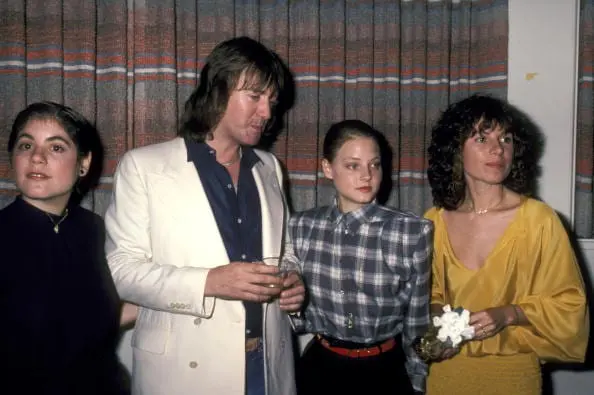
CASTING
Casting began early. Casting began in 1977 with Ayers auditioning some 40 actresses. It's unclear if anyone from those casting sessions was in the final cast.
Adrian Lyne would mistreat the auditioning teen actresses in an effort to bed them. Whatever relationship was in place between director Lyne and writer-now-producer Ayers at the very beginning of the film was destroyed right off the bat. Ayers wrote, "Adrian liked girls, that is, liked girls so much that he wanted to soften them up by humiliation since in his lothario reasoning that would cause them to turn to putty in his hands though why any man would want to make love to putty -- you get the idea. He would leave these teenaged girls waiting in the outer office for hours. When he got them in, he would be short, almost dismissive, listen to a little of what they had to offer and say "Thank you" to a girl who had dreamed of this audition for days if not longer." When Ayers attempted to show the actresses respect by reading lines with them, he said, "Adrian would sigh and fuss and take calls in the background."
Demi Moore auditioned for the role of Jeannie. At age 17, Moore didn't have much of a resume - she was a model but worked at 20th Century Fox. Her real life was very similar to what is portrayed in the film. According to her autobiography, "Inside Out," Moore was having sex with adult men (some consensual statutory rape, and some outright rape) and moved in with her 28-year-old musician boyfriend at the age of 16. Her job at Fox came through her boyfriend's mother. Moore would work with director Adrian Lyne a decade later in Indecent Proposal.
Kristy McNichol was heavily considered for Annie. Instead, she took the role of the scrappy teen from the wrong side of the tracks with a divorcee mother in Little Darlings, which came out a month after Foxes. Little Darlings was a box office hit but critically reviled while Foxes was critically adored but a box office failure.
Jennifer Jason Leigh auditioned to play Annie. Jennifer Jason Leigh was the daughter of actor Vic Morrow and screenwriter Barbara Turner. She wouldn't get this role but she would find success in Jodie Foster taking a sabbatical to attend Yale University: she took over Foster's role as an anorexic teen in "The Best Little Girl in the World" - for which she made an impression by dropping 86 pounds during filming. And, she got the star-making lead role of Stacy in Fast Times at Ridgemont High, a role Foster was in contention for but turned down.
Diane Lane and Rosanna Arquette also auditioned for Annie. Diane Lane was the daughter of a noted acting coach and had made an impression in the theater world but was only 13. Instead, she was cast in A Little Romance (with Jennifer Jason Leigh's 34-year-old boyfriend David Dukes) which instantly made her a star. Arquette was getting roles on TV but was auditioning for all the pictures of the day, including The Blue Lagoon (a role Lane and Jennifer Jason Leigh turned down); Arquette did get cast in an episode of the TV series "The Runaways" as did Scott Baio.
Foxes was only Cherie Currie's second acting audition. The Runaways lead singer was repped by William Morris after an agent caught one of her shows. She had only auditioned for Rock n Roll High School when she was sent to read for Foxes.
Currie originally read for the part of glamorous Dierdre -- and because of it, she almost walked out of the audition. "I felt that there was no hope of me landing the role. When I walked into the offices of Casablanca Filmworks and looked around at the other girls, I nearly walked right back out of the door. They were all so beautiful, with gorgeous clothes and hair, and resumes that listed dozens of movie roles. I, on the other hand, had walked into the place wearing jeans, platform sneakers, and a small football shirt with my name across it. In a movie named Twentieth Century Foxes, I didn't think I stood a chance in hell!" Currie wrote in her autobiography "Neon Angel." "I dropped my copy of the script on a table, turned around, and walked right out the door. I was thinking that maybe I could save myself some humiliation by just going home. Thankfully, that now-familiar inner voice told me to turn around and go back."
Kandice Stroh also almost walked out of the audition - for the same reason. In our interview with Stroh, she said like Currie, she was intimidated by the other actresses called to read for the part of Dierdre. She said about her audition in New York, "I almost left my Foxes audition because I saw a room full of models. I was 5’5”, skinny, and had just gotten a perm! It was another case of “what am I doing here?” that a lot of actors experience. My agent encouraged me to stay. David Puttnam and Adrian Lyne were the only people in the room and they were talking, directing and filming all at the same time. I remember David taking me aside and putting bobby pins in my hair to keep it away from my face. I read for two roles but the Deirdre telephone monologue scene was my last. I was sure that despite Adrian’s direction to be superficial and narcissistic, (since I was “deep” having done Ibsen,) I would never land that role. In fact, when I received the call to fly to LA for a screen test, I asked my agent what part because if it was for Deirdre, I was only “kidding.”
Jodie Foster's mom Brandy tried to block Currie from getting cast. Currie writes, "Although [Brandy Foster] didn't have any official role when it came to casting the film, Brandy was a powerful voice in all decisions. Although I never sensed that she disliked me personally, she obviously feared that I didn't have the experience and that I wouldn't be able to pull off an emotional and complex role like the hopelessly strung-out and doomed Annie."
Brandy Foster was also present for Kandice Stroh's callback. Stroh told us she was flown to LA to do the official on-camera screen test. "The only people at the stage, which included a bedroom set-up, were Lyne, Puttnam, the small crew, Jodie Foster AND her mom, Brandy. Jodie and Brandy sat in chairs opposite the bed as I did the monologue. We did a few takes. I spoke with Jodie and Brandy – chit chat mostly about NYC and my background."
Cherie Currie had a record deal with PolyGram. Currie had a four-album deal with Mercury, three of which she made with her landmark teen female rock band The Runaways. She left the band before meeting the terms of her contract, and Mercury insisted she make a fourth album. It was around this time she was cast in Foxes, which began filming in October 1978. The timing is all unclear but Mercury was a PolyGram label and took over the Casablanca roster as they started to go under, and it makes sense that it played into Currie being cast in her first film. However, it's then odd that they didn't have her record a single since that was the purpose of the film for Casablanca/PolyGram. On the other hand, Currie's solo album that fulfilled her Mercury deal -- "Beauty's Only Skin Deep" -- was not one that Mercury thought was solid and didn't even release it in the U.S., so it could be that she was cast with the plan of putting one of her songs on the soundtrack and then thought better of it.
What they turned down to be "Foxes." Some of the cast had to turn down opportunities to take the film. Cherie Currie turned down Rock n Roll High School (her first audition) and Kandice Stroh had to turn down a regular role on a New York-based soap opera.
Jodie Foster's brother lost out on a plumb role because his sister was cast in the film. Buddy Foster, who was known for his TV work, was up to play Brad. Since Brad was seen as a love interest for Foster's character, Jeannie, Scott Baio was cast in that part instead. Buddy Foster was given the role of "boy in car" instead.
Sheree North was Adrian Lyne's pick to play Jeannie's mother. While Ayers wanted Sally Kellerman from the beginning, Lyne originally was against the idea - something the Academy Award winner was aware of. The fear for Ayers (and likely Puttnam) was that Lyne was hoping for some afternoon delight with North, and he clearly convinced Puttnam of the same: Kellerman was cast. Ayers wrote, "Knowing he had to mend a fence, Adrian drove to [Kellerman's] house and knocked on the door. Her terrier inside raised a ruckus. Sally opened the door, saw Adrian, and turned to the terrier. 'Bite him,' she commanded."
Sally Kellerman said yes because she was a single parent to a 15-year-old daughter. In a promotional junket interview, Kellerman told reporter Bobbie Wygant she took the role because she, too, was a divorced mother with a daughter around the age of Jeannie, "My interest in doing Foxes was relating to the role as a mother because my 15-year-old daughter and I go to the mat on more than one occasion about things, and we’re holding and hugging each other on occasions. There’s a real love between us. And, we struggle for understanding. I’m of a generation where, as a mother, I demand some understanding, too..."
Sheree North did get cast anyway -- as Dierdre's mother. After Dierdre describes her mother as someone who wants her daughter to get an unattractive haircut so she'll stop stealing male attention away from her, this was definitely a character. Stroh told us there was supposed to be a family scene by the pool, and that "I recall that Sheree North, a wonderful actress, was set to play the turban-hatted, swimsuit, bejeweled mom." It was cut due to budget restrictions.
Actresses were cast had similarities to their characters. On an E! Network special about Jodie Foster, Marilyn Kagan ("Madge") said, "We all seemed to be our characters to some degree. Everybody we played had an element - Jodie included - had an element deeply within ourselves of the character."
The actor who played Jeannie's dad was actually a music manager in real life. Adam Faith, plays Jeannie's tour manager father, was Leo Sayer's music manager at the time. He had been an English pop star with a slew of hits in the '60s
Jodie Foster and Scott Baio were likely cast from their relationship with Puttnam. Foster, Baio and Puttnam worked together on Bugsy Malone. It's likely Puttnam brought them in for these key roles.
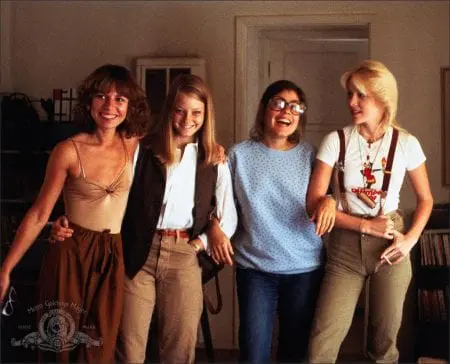
THE CHARACTERS.
Jeannie was "Jo." Jeannie is seeing writing in journals throughout the film and is a deep thinker. She reads Plato to her mother. Ayers modeled her after Little Women's Jo -- and his daughter Liz. The opening scene, which was cut the day before filming began, would have made this more clear. Ayers wrote: "The omitted scene was to have shown Jodie in her room, her gang flaked around the floor, a sleepover. She's in her window seat. Behind her, what seems like a many-colored star twinkles in the Valley night. As the girls slide off to sleep, grumbling at each other, Jodie tries to read them a poem she has just written. It was in fact written by my daughter, Liz. On a slow zoom the camera goes past Jodie through the window. The sparkling star comes into focus. It is the Jack In The Box's clown head turning in the night."
Dierdre was "Amy." "Another Alcott sister was flirtatious and always at work on her wardrobe or looks. I wrote a version of her," Ayes wrote in "Elsewhere Hollywood." Kandice Stroh told us Dierdre was a girl who went to the school in the Valley but lived in the Hills (the Hollywood Hills separate the ritzy Beverly Hills/Bel-Air areas of LA and the Valley) -- and she felt like an outsider. "She was different. She needed to keep herself stylish, current, attractive, and emotionally apart because she was insecure and vulnerable and not really a part of the group, and yet, she wanted to belong somewhere. She didn’t regularly shop for food items for herself. Her parents had staff. The reason she says 'I’m the only one who has to go to the store and buy that stuff all the time' is because she could PAY for it. The other characters did not have that ability. I don’t think she ever thought twice about a group of teens gathered for a hell-raising night. Just look at what she wore!! So, the breakdown about [not realizing she needed to buy] the dip was a catalyst for not fitting in – anywhere. Not at home, not with her friends, nowhere, except perhaps at Saks, or Neiman’s, or somewhere where she could be comfortable financially but surely not emotionally."
Madge was "Meg." "Another was naive and pure of thought," Ayers wrote. "Surprisingly she is the first to marry and that to an older man. Though simpler than the others, not hip that is, she was the only one to know the truth of what she felt and comfortably acted on it."
Annie is "Beth." The late best friend of Ayers' daughter was the inspiration for Annie. Ayers wrote, "Liz was shaken by the recent death of her closest friend, Katy, a beautiful girl with Rita Hayworth's flowing red hair. Liz loved her most even though the girl was addicted to Southern Comfort and hopped into beds she quickly forgot about. She stole Liz's boyfriend from her. Liz wrote to me: 'We used to have fun, but then Katy started having too much fun. And then she wasn't having any fun at all. She was an alcoholic, we knew it at the time. Oh but Katy was beautiful, not just in looks but in everything about her. I cry sometimes when I think about her, but mostly I just smile. How could I help but smile, when I see those sunshine eyes.'"
But wait, Annie is BETH? Obviously, the personalities of Annie and Beth are polar opposites. But, Ayers explains: "Then there was the wild one, the one based on Liz's Katy whose excess of spirits sends her off to drugs, bad choices and early death. The role was played by Cherie Currie. Her equivalent in Alcott's book also dies early, but not from excess of spirit but an excessive lack of it. She is drained. The sap is gone from her as she dies. One with too much sap, one with too little. Both extremes. Both ending in death."
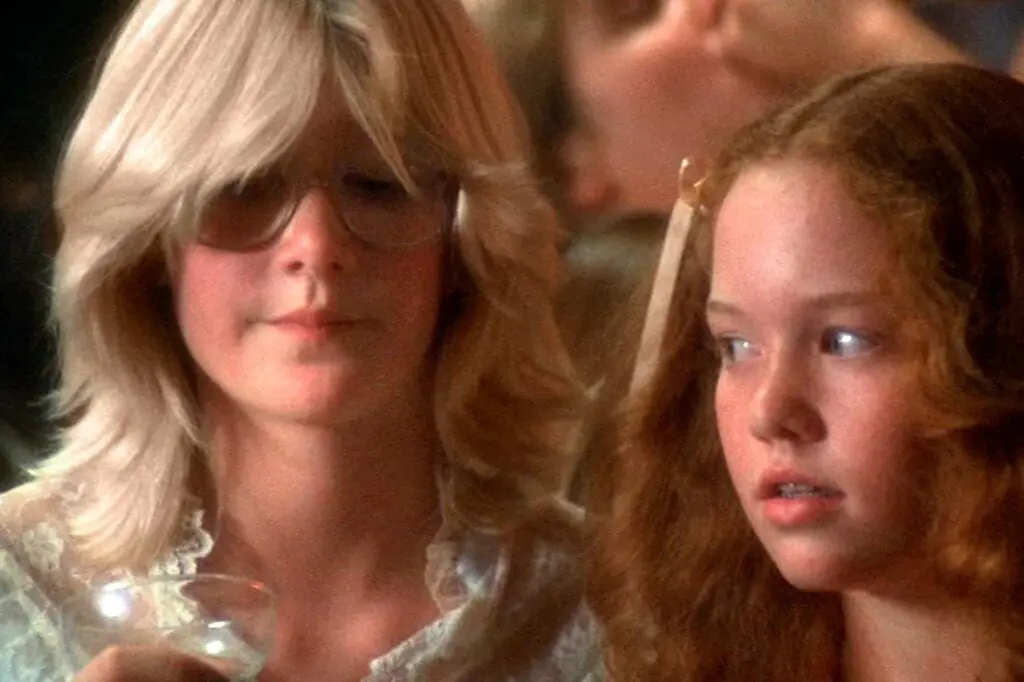
FILMING NOTES
That's NOT improv. Several scenes have the girls bouncing off each other, particularly the breakfast table scene. It's so natural, off the cuff, and not always relevant that it seems like they could be riffing. They're not. "We met for the first time on a stage and had 2 weeks of rehearsal with the writer and director. That was quality time spent. Most of the scenes were group scenes, kitchen table, etc.," Kandice Stroh told us. "For the most part, everyone adhered to the written word. Gerald Ayers, the writer, had a pretty solid sense of the appropriate dialogue. I think the characters each actor developed, their tone, body language, choices, etc. made it seem non-scripted at time but that’s a testament to the work."
Adrian Lyne established the lighting and camera work that would become his hallmark. It may have been his first feature film, but Lyne's soft focus, light filtered, gauzy images are present. Lyne typically makes films with an erotic edge. While Foxes certainly doesn't fall into that category, Lyne's sensual camerawork makes innocent shots seems sexy. For instance, the establishing shot of four girls having a sleepover is meant to evoke the understanding of their young age to contrast with the adult conversation they'll be having soon. But, Lyne's panning over their sleeping bodies confuses the viewer who thinks there is something sexy going on (there's not). Other analysts and reviewers have also been confused by the girls cutting up to make fun of the leering boys on the way to the concert (no, there's no lesbian thing happening), when Jeannie spends the afternoon with Brad after Annie's been taken to the mental hospital, and when Jeannie is fighting for Annie (again, there's no lesbian love guys, they're just friends - this is how girls act with each other.
Jodie Foster would roll her eyes at Adrian Lyne's directorial choices. Adrian came from commercials so he would shoot endless footage of extras fooling around, inserts on make-up or on snacks being unwrapped...ambience. Things that had nothing to do with the plot but were little discoveries for him. I rolled my eyes at the time because I thought it was wasteful. But that was Adrian's directorial style emerging. He just got a kick out of being there among young people and wanted to shoot anything that moved," Foster told James King for "The Ultimate History of the '80s Teen Movie" His work always has the sparkle of mischief...just like him. He's a big kid."
Foster now believes the film succeeds because of Lyne being a newcomer to Los Angeles. "There I was working with a first-time British director doing a movie about adolescent girls in a city he barely knew. I think that's the strength of the movie, its fascination with that place and time," Foster told King. "He was an outsider who was captivated by the look, the feel, the energy of one moment in time. It was a curiosity to him. An Englishman discovers The Valley."
Producer David Puttnam said that all those background shots were a bit of a British wave. He told King you can see a similar discovery from John Schlesinger in Midnight Cowboy. "Schlesinger's view of New York -- and I remember this very vividly from when I first went there in the very early 60's -- was an outsider's view. He found it a very extraordinary place in a way that people who lived there didn't find it extraordinary at all...Coming from the outside, you do tend to have a different view. In some cases a touristic, slightly obvious view but in other cases you notice things that locals don't notice at all."
The soft focus sun-filter didn't come from Adrian Lyne. Lyne would move forward in his career using light to sexify women and scenes, but it wasn't initally his move. The gauzy look came from cinematographer Michael Seresin, the director of photography. He was also a Puttnam hire: he's worked in the London ad scene and was the DP on...you guessed it...Bugsy Malone.
Jodie Foster shut down the set when another actor acted unprofessionally. Cherie Currie recounted a story where a male actor - it's unclear which one or it was an extra - was a little too rambunctious to the point of crossing a line. "He basically jumped on top of me -- planted a huge kiss on me, practically putting me over the back seat of the car," Currie said to E! "Jodie was furious because it really wasn't what the scene called for. She shut the set down for two hours because she just thought that was inappropriate behavior."
All those outdoor shots? The cast was freezing. Jodie Foster recalled how cold it was during filming, "There was quite a bit of night shooting on Foxes and it was freezing cold in Los Angeles that winter. I got frostbite on my toes from wearing Candie's open platform shoes."
Laura Dern didn't understand the meaning of her dialogue. A 12-year-old Laura Dern has her first speaking role as Debbie, the classmate who keeps pushing to get into the dinner party and then advises a friend about birth control. Lyne and producer David Puttnam asked her if she was comfortable with her lines. She told New York Times Magazine in 2019 that: "...she didn’t understand what the problem was. It was just a diaphragm, right? You took a deep breath and it expanded below your rib cage? 'That’s an awkward first part' she laughed."
Robert Romanus didn't know what a "mark" was, so he didn't hit it. Romanus told Rockerzine that Foxes was his first acting job, which was a bit of an issue on a feature film. "I had no idea what I was doing as an actor or technically," he said. "The very first scene that I had in “Foxes” is the concert scene. There is a crowd of about two hundred people and I have to walk down this long hallway, hit a mark and say my line to Jodie Foster. But I didn’t know what a mark was. It took twenty-eight takes. I put everybody on overtime. It was horrifying. The next day the director, Adrian Lyne, came in and said, 'Listen Scott, I know you can do it. I saw you do it yesterday.' Then I had my second scene and it went well. I was on my way. Three years later I got my next job."
Jodie Foster advocated to add the climactic face off between Jeannie and Annie. Ayers wrote that Foster approached him, thinking the two best friends of the friends needed to have an argument. "The strength of their love, Jodie suggested, was always expressed in anger. It was their manner. Too suspicious of sentiment, feeling it had let them down too many times, they still need to speak their feelings. It comes out in a rant of love."
Adrian Lyne was a yeller. "Adrian was a director. He directed. He got mad, and he did all the things you think directors should be doing from having seen directors in movies," Scott Baio told AV Club decades later. "It felt like real movie making!"
Cherie Currie wasn't on drugs during the film, or at least, not much. She said to Sally Jesse Raphael, “Before I became a cocaine addict, I was a Quaalude addict because I was doing more downers when I was with the Runaways… It was not normal for me not to have cocaine on me, whether I used it or not. I did Foxes and I tried to use as little (cocaine) as possible while doing the shoot, I wanted to feel ‘responsible.’
Wait, do you count ampethamines as drugs? For her, Currie was clean for the start of Foxes. However, she admits she snorted Benzedrine in her autobiography "Neon Angel," "But Benzedrine was legal, so I felt that it really wasn't a drug at all. I mean, if doctors could prescribe it, how bad could it be? Okay, you weren't supposed to snort it like I did, but that's just splitting hairs. Just because it was a white powder that pumped me up didn't mean that it was anything like coke. And it wasn't as if I did it every day. Well...I did do it every day, but I only did it in the mornings."
By the end of the shoot, Cherie Currie returned to doing cocaine. Currie writes that her hair started falling out and creating red welts on her scalp. She blamed the Benzedrine. Right after she noticed the bald patches, she threw away the Benzedrine and called her coke dealer.
Once filming began, the studio made them change the ending. Did you think Annie was suicidal? And that her car crash scene didn't match up with the rest of the film? Then you caught on. In the first scene, Diedre scoffs when Jeannie and Madge try to wake a passed out Annie, saying, "What the shit? She doesn't care if she never wakes up." That's the foreshadowing. Producer David Puttnam said in "The Ultimate History of the '80s Teen Movie" they were forced to change how Annie died: "The original script was about a girl committing suicide and the studio at the end of the day backed off of that and it had to be an accident."
Jodie Foster laughed with the girls about her crush on Scott Baio. The two had co-starred in Bugsy Malone three years prior. Marilyn Kagan said Foster was chatty with the other girls on set, including dishing on herself. "She was very open and available and talking about when she had a crush on Scott Baio years ago...they were very cute together and still good friends."
Laura Dern was also crushing on Scott Baio. She told Entertainment Weekly how she intended to get Baio to notice her on a day they weren't filming. “I saw him from across the room and he was wearing a white leisure suit. He looked so stunning and I was so excited, and I knew I was about to make the best first impression and he would love me forever.” Dern had brought her dog with her to the meeting. “My dog got her period on his [Baio’s] pantsuit.” Dern said she “got down on my knees with a bottle of club soda and proceeded to clean the blood out of his pants. It went over really well. I’ve actually never seen him again.”
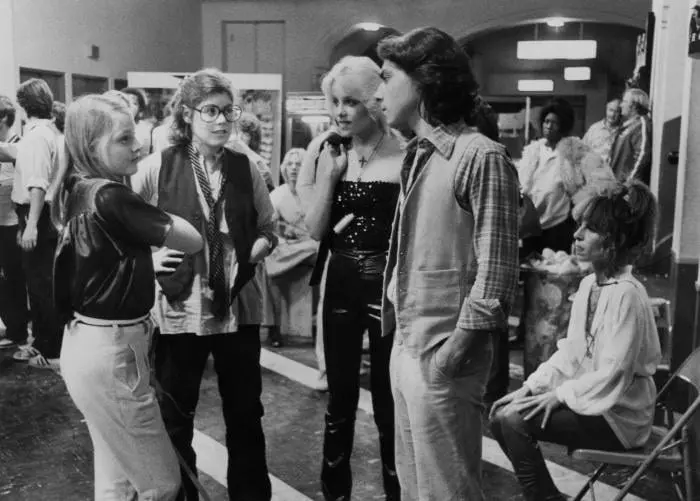
ALTERED SCENES
The concert scene was drastically altered. Lyne changed many things about the script, but the one that irked writer Gerald Ayers the most was the scene at the Shrine Auditorium. For starters, it was written to be at the Santa Monica Civic Auditorium for a good reason: the entire scene was built around the idea that the lobby had wrap-around glass doors. Here's how the scene was supposed to go down, from Ayers' autobiography:
"What I had written for the Iggy Pop performance was a leather-clad fan, a black kid with snake skin boots up to his crotch. As Iggy stooped over and glided sideways like a spider keeping an eye on us, the black kid crawled up the stage. Security guards hauled him out on their shoulders, one snake-skinned boot sticking above like a mast. In the lobby, they throw the kid out one of the glass doors. He charges the door. As my Valley middle-class rebels watch, the security guys step out and beat the s--t out of the kid. He scratches at the door, blood running, as Jodie and her boyfriend discuss their romantic problems. Adrian, as said, was a Brit. As such his knowledge of Los Angeles came from films, probably older films. He chose for locations anything he could find that was pre-World War II. Abandoned railway tracks, for instance. How many girls walk home from Uni High on railway tracks? What he didn't choose is what was in the script: Sambos and Tower Records, the haunts of my young girls. Perhaps because of his attention-deficit skill in making TV ads, Adrian used cliched symbols rather than to linger to observe the quirks of character. He seemed ill at ease with messy human emotions."
The skateboard chase was inserted to make use of Casablanca music. "The film was essentially funded by a music company and therefore the pressure was on us to use music...in some ways inappropriately was there," Puttnam said. "The skateboard chase, for example, was there in order to advertise the song. Otherwise I'm not sure what it was doing in there."
Dierdre's parents were cut out completely. Kandice Stroh told us she fought hard to keep the scene with her family in the script, and that Adrian Lyne didn't want to cut it either, but ultimately, it was a budget cut. "There was a wonderfully sad but funny pool scene at my parent’s home, somewhere between Beverly Hills and Mulholland Drive. You see, Deirdre, despite being friends with these Valley girls, was from a wealthier home. Okay, hard to reconcile, but had that scene been in the film, perhaps it would have not only added depth to her character but also, a firmer understanding of why she was as she was." She adds that Sheree North was cast as a fabulous mother, but she was unsure who was to play the step-dad, Franklin. But he was quite the character, right out of Sopranos – gold chain, cigar, belly, shitty role model – at least that’s what the script described."
Dierdre's exit scene versus her disappearance. It's a little weird that Madge gets married and Dierdre isn't at the wedding. The message is supposed to indicate that in the year that followed Annie's death, the friends have drifted apart. A mention is given that Dierdre is off with some guy. But, originally Dierdre maybe had the happiest ending. Kandice Stroh told us, "In the script, Deirdre walks off to a happy life with a preppy, well-schooled, appropriate boyfriend and her hair is no longer permed. It’s a wonderful life!!!"

FUN FACTS
Angel was a real band. The band with the platform shoes and white over-the-top costumes isn't made for the movies. Angel was a Casablanca music act and were inserted into the film to drive sales and interest. If it feels like the slot was made for another Casablanca artist, KISS, you're right - but, Angel was available. The script had designated Iggy Pop to be the act.
The premiere was a fundraiser. The Feb. 26, 1980 premiere took an unusual approach. Instead of a lavish affair, it served as a philanthropic effort to raise money for the Free Arts Clinic, which provided art therapy for abused children. The effort brought in $30,000 for the nonprofit.
What Would Stephen Do? Is Donna Summer was Giorgio Moroder's muse. He created disco and she was his disco queen. He wrote the music for the song but Summer was to write the lyrics and she was having a tough time when she had an epiphany of how to work around her writer's block. She told NPR's Fresh Air in 2003: "I was at the piano, and Stephen Bishop's record was on the top of the piano, and I looked at the record, and I know Stephen, and we've written together, and I'm like, you know, how would Stephen say this? What line would he come up - he's so clever. And all of a sudden, this one line came to me, and it was 'must have fallen out of a hole in your old brown overcoat,' and it was like a lightning bolt. OK, that's it. I knew who the person was. I knew who the person was in the song, I knew who she needed to be, I knew what she was going through, I knew what had to be said. And so as soon as I got all of the personal information on the character, I was able to go into the studio, stand on the microphone and sign the song pretty much verbatim, the way you hear it."
Jodie Foster's mom made sure a friendship did not develop between Jodie and Cherie Currie. Currie told E!, "Brandy, Jodie's mom, really didn't like me and didn't want me to be in the film." While Currie has spoken about how "sweet" and helpful Jodie was to her on set, Brandy stepped into make sure any camaraderie they felt stayed on set.
Cherie Currie filled the down hours on set by doing macrame. Jodie Foster said that Currie used her down time to do crafts, including cord knotting:"Despite the tattoos and rock star hair, she seemed very naive, very young. She lacked confidence in her acting ability and was always checking in to make sure she was on the right path with the character. But I thought she was good, so real, so clearly tapped into the truth of that character."
Jodie Foster had a crush on Gerald Ayers. Foster may have crushed on Scott Baio during Bugsy Malone, but for Foxes, it was the 43-year-old writer. Ayers wrote that he'd sported a mustache during filming but shaved it off for interviews: when he saw 15-year-old Foster, she burst into tears. During the publicity photos, she jumped into his lap. He was baffled. Until the other young actresses filled him in: "Jodie had a thing for me." He said he solved it by finding a way to mention he was gay.
Gerry Hambling is the real editor of the film. Hambling was David Puttnam's chosen splicer and took over Lyne's work. Still, Casablanca was not happy with the final product. They asked Ayers to recut it, but he said it was difficult became Hambling was "top drawer" - he did good work, it was difficult to find better cuts. The best solution was to let Gi
"Who is this guy? The Boston Strangler?" Jeannie says this line when Madge reveals she nuzzled in a guy's neck rather than have sex with him. Sally Kellerman, who plays Jeannie's mom, was in the film The Boston Strangler.
Robert Romanus would later be in the film The Runaways. The film was based on Cherie Currie's novel "Neon Angel" about the wild life she had in her young women's rock n roll band. He played a music teacher. Romanus is a musician as well as an actor.
...And Scott Baio was in a TV show called "The Runaways." Baio was a one episode guest star.
Scott Baio and Grant Wilson had just worked together. Wilson plays Diedre's grocery store crush Greg and it may have appeared to viewers that Baio recommended Wilson for the Foxes job: he was on a "Happy Days" episode that aired Sept. 1979 and Foxes came out early 1980. However, since filming for Foxes was over the fall and winter of 1978, it's more likely Baio recommended him for the "Fonz meets Kat Mandu" episode of "Happy Days."
Jodie Foster was fighting with her mom during filming. Foster said she had just turned 16 herself and they had all the mom-daughter tension that comes with that age. "I was mad at my mom during that shoot because she was always late driving me to the set."
Sally Kellerman does not hate her hips. The most memorable and quoted line from Foxes is when mid-battle with daughter Jeannie, Mary admits she's jealous of the lithe figures of the teen girls, saying "You make me hate my hips!" In 1980, Kellerman told reporter Bobbie Wygant, "I live with a man who thinks my hips are wonderful, so I don’t have that to worry about!"
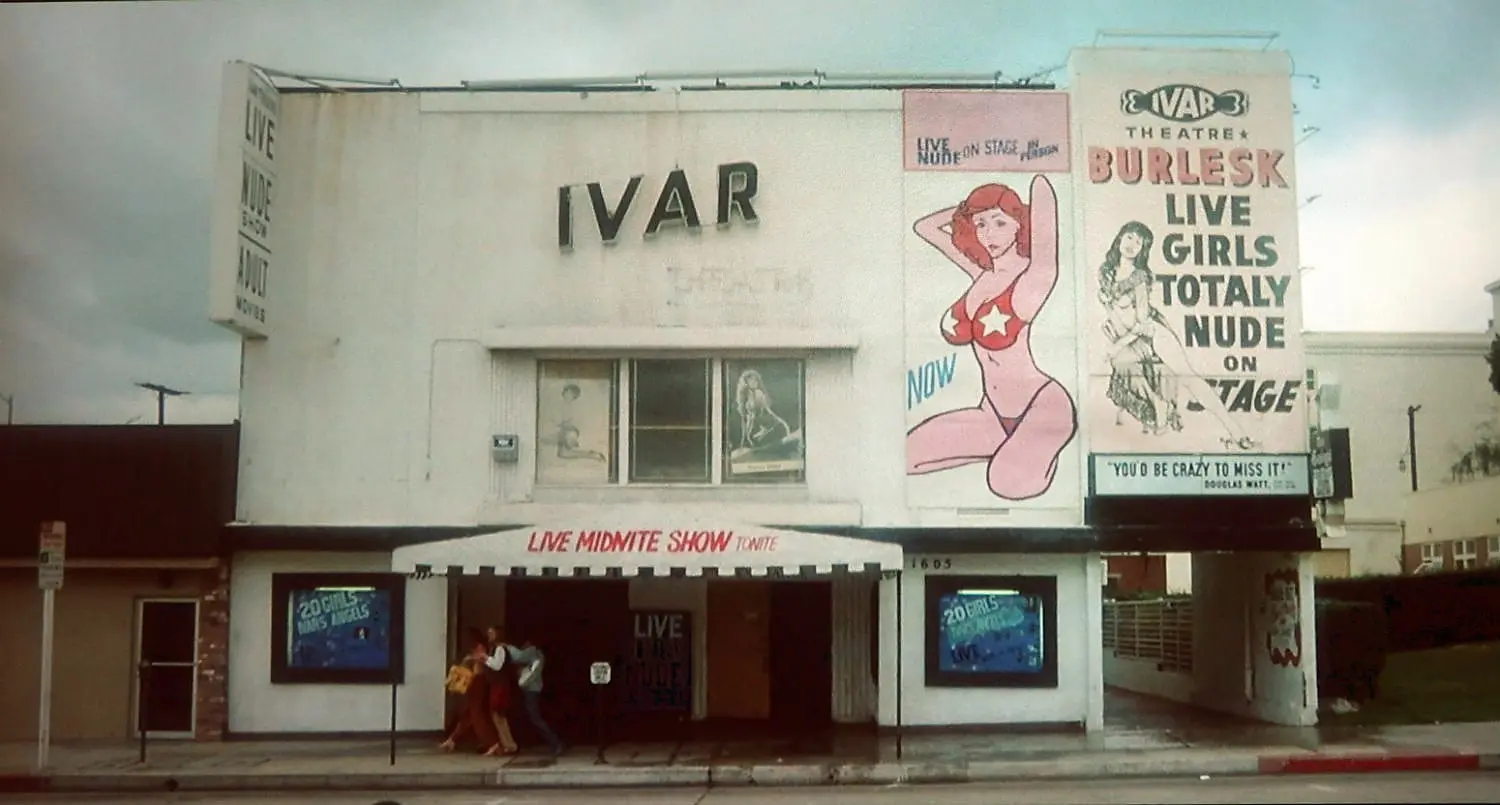
LOCATIONS
Los Angeles is a character. Just as Manhattan is a character in Sex and the City. Los Angeles is a character in Foxes - specifically The Valley. Scott Baio told AV Club, "It was a great movie to be on, great fun to make. We shot all over the San Fernando Valley, and it was just a damn good movie."
The porno theater is not near the girls high school. While director Adrian Lyne was striving for accuracy, the adult film theater featured is not in The Valley. The Ivar Theater is in Hollywood.
Jeannie and Brad's deep conversation was near the aqueduct. When Jodie Foster and Scott Baio smoke grass and eat lunch in a dry desert area with pipes, it's the Joseph Jensen Filtration Plant in Granada Hills, according to San Fernando Valley Blog. Los Angelenos will know it as the Cascades, the waterfall on the side of the 5 as you drive north to Valencia/Santa Clarita. Exact details of how to find that location are on a YouTube page dedicated to this location.
Lucky Liquor and Tony's Lof 'n Time were both in North Hollywood. For those who don't live in LA, North Hollywood is not in Hollywood, it's in the Valley. Neither business still exists.

REVIEWS
While most agreed it wasn't a perfect film, Foxes was critically acclaimed for its rare authentic portrayal of teen sruggles . It has a 67 percent fresh rating on Rotten Tomatoes.
Roger Ebert awarded it three stars and gave it a favorable review, describing it as "an ambitious movie, not an exploitation movie." The Chicago Sun-TImes critic acknowledged the film for what it was trying to achieve: "It contains the sounds and rhythms of real teen-age lives; it was written and directed after a lot of research, and is acted by kids who are to one degree or another playing themselves. The movie's a rare attempt to provide a portrait of the way teenagers really do live today in some suburban cultures."
Variety also called it "an ambitious attempt" that "ends up delivering far less than it is capable of." It goes on to say Foxes is a "depressing, one-sided and melodramatic treatise on American youth."
Macleans Lawrence O'Toole called it "teen angels with trimmed wings." Writing for the Canadian publication, O'Toole was not a fan, taking aim at what would become Adrian Lyne's signature look: "Visually, nearly every shot (underexposed to create moody, poetic effects) has to make a point—not for the pushy, full-of-holes Saturday Night Fever-ish plot contrivances, but for the filmmakers—the movie keeps saying I have gone to film school." O'Toole is now a suburban New York Realtor.
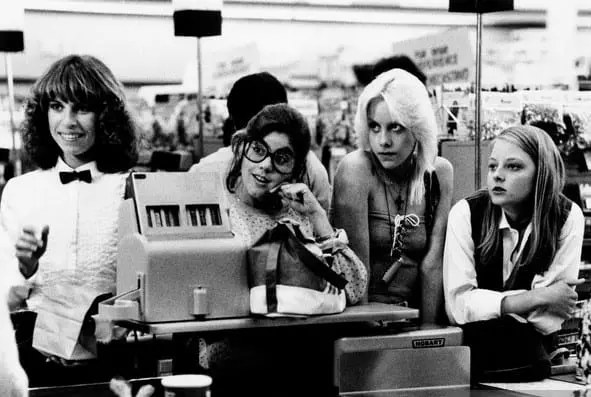
LEGACY
Foxes is a cult classic and considered one of the most authentic teen films of all time. While the film didn't make a splash at the box office, it's gained support through the years as a through-the-keyhole look at what teen life was like in the anything goes days of disco.
Foxes created the map for the '80s music movie and the '80s teen movie. Casablanca execs read the tea leaves correctly: music and movies were a match made in a money truck. As the '80s progress, popular music starts to get put into the score until finally, Footloose in 1984, which showed the rest of the industry how to make a soundtrack movie that can get maximum play on radio and MTV. Similarly, while teen movies would initially grow in the sex comedy arena, studios would strive to get more authenticity with experiences and conversations as seen in 1982 with Fast Times at Ridgemont High and The Last American Virgin. Then, in 1984, John Hughes takes over with Sixteen Candles.
Adrian Lyne's career skyrocketed. The critical success of Foxes allowed Lyne to get Flashdance, which led to 9 1/2 Weeks, Fatal Attraction, Indecent Proposal, Unfaithful, and the remake of Lolita. He is known (among studios filled with men) as a director who knew how to "authenticate the feminine struggle, desire and agency." Whether or not you agree with that, he should be recognized for putting a strong or dominant female perspective in his films and that since getting his first shot with Foxes, most of his films are written by or produced by women.
Cherie Currie got a nice second life as an actress. Currie left The Runaways the year before filming Foxes, her acting debut. She made a solid impression and booked several roles after that while also following her art in other creative pursuits, including continuing to make music and becoming a noted chainsaw artist.
Jodie Foster left the entertainment industry for a few years to attend Yale. Unlike other child actresses who took the time off (like Brooke Shields a few years later), she was able to return to acting without a hiccup, starting with The Hotel New Hampshire with Rob Lowe in 1985. She got her first shot at directing that same year with a segment on the straight-to-video Stephen King's Golden Tales. In1989, she won her first Academy Award for Best Actress for The Accused and four years later won a second Oscar for Silence of the Lambs. In 1991, she made her directorial feature debut with Little Man Tate. In 1994, her production company Egg Pictures made its first film, Nell, which got her another Oscar acting nomination.
Marilyn Kagan became a daytime talk host. After getting steady film work in the '80s, Kagan became a licensed therapist. In 1995, she hosted The Marilyn Kagan Show; it lasted three seasons. She also hosted an advice show on talk radio, LA's KFI. In 1996, she played a therapist on "Ellen," Ellen DeGeneres' landmark sitcom (although she was on it the year before it became groundbreaking). She continues to practice as a Marriage and Family therapist in Los Angeles.
Kandice Stroh continues to act and serves as an acting coach. "I am still acting - if I find or have the opportunity to read for material that's challenging and interesting, I'm there. My last major film role was a lead in Sound of My Voice. I continue writing. I'm working with two international screenwriters on scripts," she told us. "I also have students, most of them actors and screenwriters, even a few people in finance and business, for one-on-one accent reduction lessons."
Scott Baio's popularity grew...until Trump. Baio was already a Teen Beat cover boy at the time of Foxes because of his role as Chachi Arcola on the ABC sitcom "Happy Days." He followed up Foxes with his own short-lived but memorable spin-off "Joanie Loves Chachi" and a teenspolitation movie of his own, Zapped (1982) about two teens who get the superpowers and use them to lift girls' skirts. He worked steadily, producing and hosting the reality series "Confessions of a Teen Idol" and becoming a reality star in VH1's 2007 series "Scott Baio is 45...and Single." However, when Donald Trump ran for president in 1996, Baio's popularity sunk when he endorsed Trump and, as one of the few "stars" who backed him, became a Fox News fixture. He was since #MeToo'd by Nicole Eggers and Alexander Polinsky, the children he was "in charge" of on his hit sitcom "Charles in Charge." All the online quotes from Baio about Foxes are on this page; trust us, you don't want to Google "Scott Baio fox interview."
Soundtrack
The power of three music labels -- Polygram, Casablanca and Oasis - behind one movie generates a sensational soundtrack. Music producer Giorgio Moroder, nicknamed "The Father of Disco," assembled and composed the soundtrack. Moroder's longtime muse, Donna Summer, was the featured artist. "On the Radio" was Summer's 10th consecutive Top 10 hit and was the last time a song of hers would hit the Top 5. By 1980, disco was officially declared dead. Rock was just getting started and while Angel didn't have the staying power of KISS, the band they emulate, their on-screen performance in Foxes lives forever. Folk singer Janis Ian's single "Fly Too High" reached No. 1 on the charts in various countries and earned her a Grammy nomination.
Director: Adrian Lyne
Screenwriter: Gerald Ayers
Release Date: Feb. 29, 1980
Rating: R
Opening Weekend Rank: #2. But, it seems like some information wasn’t reported because that just doesn’t make sense.
Opening Weekend Box Office: $221,000
Lifetime Gross: $7.5 million
Budget: unknown
Production Company: Casablanca Filmworks
Distributor: United Artists


